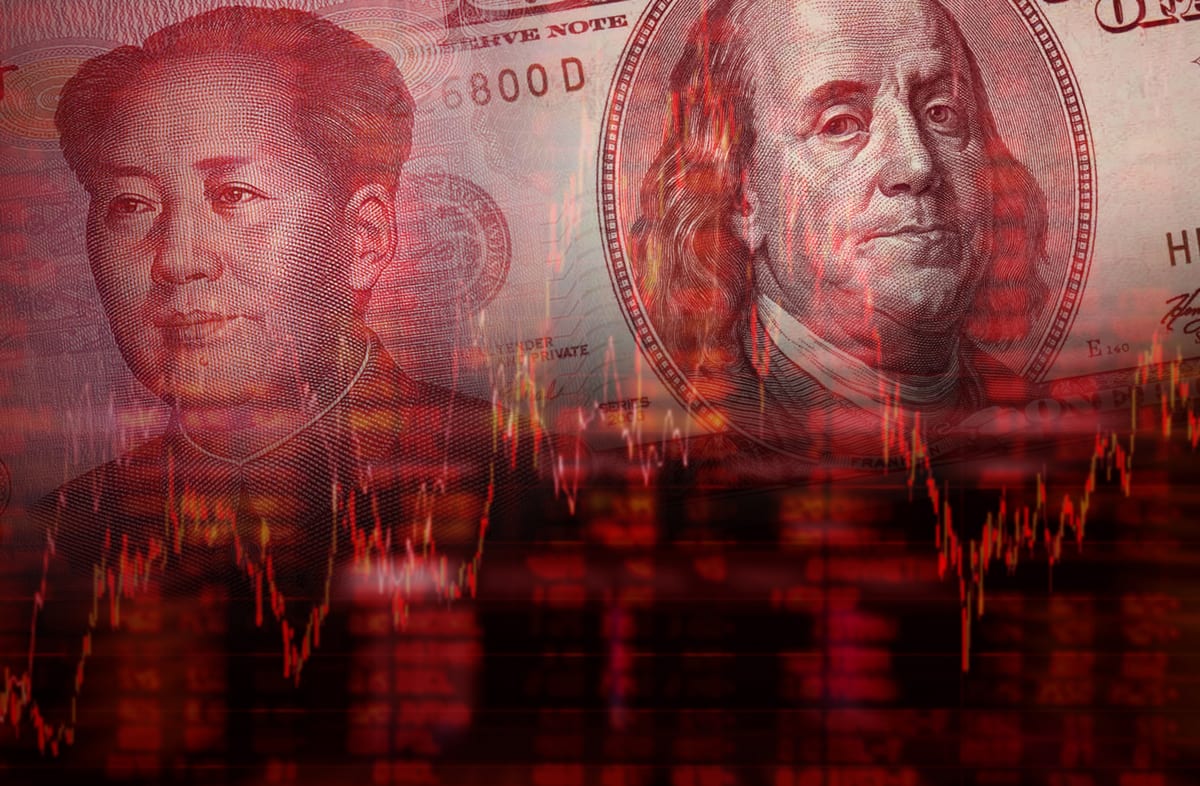Analysts Concerned High Risk Debt in China Will Bring on Echo of 2008
There aren’t many people over 30 who don’t have grim memories of the 2008 financial crisis … and the Great Recession that followed.
The collapse of Lehman Brothers, a massive and global bank, almost brought down the world’s entire banking system.
It was only the massive taxpayer funded bailouts from the Obama government that saved the world from complete collapse, and a devastating global depression.
Even so, the collapse of Lehman Brothers in September of 2008 plunged the world into its worst recession since the Great Depression of 1929.
Even today the Gross Domestic Product of many countries is still below the 2008 peak, particularly in Europe.
The question that plagues economists and investors is, can it happen again?
And the answer is yes.
The 2008 Great Recession was caused by foolish and greedy investment and loan practices, unregulated by governments who stupidly agreed with the concept of the market regulating itself.
What they forgot is, when the market regulates itself, it punishes foolish banks and investors by crushing them.
And right now, a potential repeat of 2008 is brewing in China. The villain this time isn’t sub-prime debt, but something called Wealth Management Products, or WMPs. These are highly risky debt instruments funded by Chinese investors in China’s lucrative shadow banking industry.
HOW THE GREAT RECESSION HAPPENED
Before considering what’s happening in China, one of the hottest economies in the world, one first has to understand how the world was plunged into a recession in 2008.
It really started with the financiers in America who temporarily enriched themselves and their companies by providing high-risk ‘sub-prime loans’ to borrowers with poor credit histories.
Americans could suddenly buy more expensive homes, because the banks provided loans at below the prime rate. In some cases, there was initially no interest at all.
Because mortgages are usually considered low-risk debt, these risky mortgages were bundled together into supposedly low-risk mortgage backed securities called CDO’s. The Collateralized Debt Obligations were in turn sold to investors, and everybody made money all up and down the line.
These securities got Triple A credit assessments from Moody’s and Standard and Poor’s, but the credit agencies were later found to have given far too much latitude to the banks … their biggest clients. In truth, a large percentage of the debt was held by people who couldn’t pay their mortgages, especially when interest rates went up.
As time went on and the real estate market kept booming, the banks looked for more and more risky investments, and found them.
It all held together until people began inevitably defaulting on loans, and in 2008 it hit a tipping point.
The banks had more debt on the books then they could cover, and across the country banks large and small began to fail. The country’s financial system was mere months away when the Obama administration reluctantly agreed to bail out the big banks.
But that didn’t help the millions of people who lost their homes, their jobs, and their life’s savings.
I remember being in Las Vegas right after the crisis hit, and the taxi driver at the airport tried to sell me his two bedroom townhouse for $25,000; about the price for a new Honda Civic.
People forget quickly just how bad the economy was hit … and unfortunately, some of the same things that led to the 2008 collapse are happening in China today.
The near future of the world economy literally depends on whether the Chinese government holds true to its promise to crack down on high risk investments in the shadow banking economy.
THE INVESTMENT BUBBLE THAT’S ABOUT TO BURST
Just as CDOs and sub-prime loans caused the 2008 crisis, China has its own economic bubble created by heavy investment in Wealth Management Products, or WMPs.
When Chinese citizens are offered a choice of savings plans, they are usually offered a bank account that might pay two per cent interest, or a WMP investment that pays six or seven per cent.
And because China doesn’t have much experience with direct investment, most Chinese believe the government will bail them out should the WMPs fail.
Middle-class and wealthy Chinese have poured a shocking $12 trillion USD into WMDs and similar products since 2008 … and many still believe they will be bailed out by Beijing if the investments go sideways.
But that’s not the case.
Back in February, alarmed by the huge increase in WMP holdings, the government drafted legislation making it very clear there are no state guarantees for WMP investments.
That might not be so scary, but by their nature WMPs are riskier investments, because they’re based on equally risky loans by the shadow banks.
THE BIRTH OF THE WMP
As most people know, the Chinese economy has been on fire in recent decades.
The growth in the economy, the GDP and the average income of Chinese citizens has been so impressive it’s often referred to as the Chinese Miracle.
China has the second largest economy on earth, and the fast growing economy.
But, it’s not a miracle.
It’s just the typical model seen as a poor economy transitions into a middle income economy, and it’s the same thing that happened in Thailand and Malaysia.
In the case of China, growth has occurred as the Chinese government and banks invested heavily into economic development.
Poor rural farmers and workers flooded into the cities, and thanks to a combination of investment and low wages, China began taking over a large amount of the world’s manufacturing market.
This in turn drove wages skyward, but only so far.
Even today the average person in China earns about $8,000 a year, compared to about $40,000 in the US.
The government is under a lot of pressure to keep that economy growing and wages increasing, but moving from a middle income country to a high income country is very difficult.
So, China has opted for massive financial stimulus. Some of this happened through direct government investment, but a lot more came through Chinese banks.
To help drive that type of investment the banks adopted products in the so-called ‘shadow banking’ sector; products that are not backed or guaranteed by government, and are not insured by any other body.
And those products are very high risk.
PROGRESS FUNDED BY BAD DEBT
If you travel to China today, you’d be astounded by the architecture, the high-speed trains, the gleaming airports and superb highways.
It truly is impressive … but there’s a problem. These projects are not capable of generating the revenue needed to pay back the banks.
The country is dotted with so-called Ghost Cities. Literally, these are cities built for hundreds of billions of dollars, where no one lives, because there was no economic reason to build it.
The rail system is impressive, but the low prices charged for tickets means they are doomed to operate at a loss forever.
All of which is fine … unless they were built with debt.
Today, corporate debt in China is closing in on 170 per cent of GDP. (Danskebank)
By contrast, the US is considered to have high corporate debt at around 70 per cent of GDP. Japan’s economy blew up when it reached the point of roughly 150 per cent of GDP, and the Asian crisis in the 1990s happened when Korea hit 110 per cent of GDP.
Simply put, China has too much corporate debt, invested in projects that can’t pay the money back.
Instead, the money has been raised by citizens who pour their savings into Wealth Management Products, and the WMPs are being used to prop up more and more risky debt.
This is exactly what happened with CDOs before the crash in 2008.
If the WMDs start to fail, investors will start to pull their money out of the market. The banks won’t be able to sustain the massive debt … and may have to default.
When you consider these shadow banking investments totalled 27.6 per cent of all banking activity in China, you start to see the magnitude of the problem. (Source: Moody’s, Danskebank)
Already this year Moody’s has downgraded China’s credit rating, and fellow rating agency Fitch warned the company Baidu (China’s version of Google) is in danger of defaulting because it has been heavily involved in the shadow banking industry.
Baidu currently has $25 billion yuan in WMPs as of April this year, more than double what it held last year.
Fitch points out that Baidu wouldn’t necessarily go broke themselves. The company has no obligation to pay back investors should their investments fail … but of course the investors themselves would be ruined.
So Fitch has put Baidu on a ‘Rating Watch Negative’, which may result in its A rating begin downgraded.
ALL EYES ON CHINESE GOVERNMENT IN LATE 2017
The high risk of the WMPs were first brought up by Charlene Chu in 2012, who then worked for the Fitch rating agency.
Chu now works as an analyst at Autonomous Research, and told Bloomberg last month she believes the leadership in China may be serious about cracking down on high risk debt and investment.
Chu says the economy in China is still strong, and leaders are taking advantage of that fact to impose new restrictions on high risk capital.
Several measures were taken from March through the end of April, including new guidelines on stepping up risk control in the banking industry, requiring lenders to ensure stable asset quality, improve liquidity risk management, strengthen their bond and investment businesses and improve interbank operations.
The new measures have spooked investors and put downward pressure on the Shanghai Composite Index in March.
Some analysts are skeptical China’s leadership will stay the course and make the changes necessary, but Chu believes the Beijing government is serious about dealing with its $28 trillion debt.
“We are right about in that stage where in the past they have backed down,” Chu told Bloomberg last month. “What’s different now versus the past is that they seem to have some tolerance for pain, which is a surprise in a leadership reshuffle year.”
If China sticks with the plan, Chu says the country can over time deal with its debt, but will suffer reduced growth and likely increased unemployment.
As well, some lenders will fail, and their investors will lose significant capital.
But the alternative is far worse.
THE DOOMSDAY SCENARIO
If China does go back to ‘business as usual’, and allows banks to pile up more bad debt, analysts fear the world economy, already weakened by 2008, will suffer a near-fatal body blow.
Just as in America before the collapse, and in Japan before its financial meltdown, housing prices in the major cities like Shanghai and Beijing have reached 16 times the average family income.
Personal and corporate debt are at an all-time high, and it would take only a moderate increase in interest rates to topple this house of cards.
Put simply, China has created a higher percentage of credit compared to GDP than any other country in recent history.
And in every one of those other cases, a significant economic collapse followed.
As the South China Morning Post points out, the United States created new credit (debt) equivalent to 58 per cent of its GDP between 2002-07, followed by the 2008 crash.
Spain created debt equal to 116 per cent of GDP at the same time, and still faces 20 per cent unemployment today.
In the 1980s Japan did the same thing, creating new debt equal to 100 per cent of GDP, and the once-dominant economy has been ravaged by more than 20 years of deflation.
China breaks all those records by a country mile.
Private sector debt increased by 139 per cent of GDP in the five years from 2009 to 2014, and has been rising since then.
And a lot of that debt is risky, or worse, unsustainable.
And this is why, for those watching carefully, all eyes are on Beijing during the latter half of this year.
If Beijing stays the course and takes action to reduce its high risk debt, as I believe it will, the country can escape with only a temporary downturn in its roaring economy.
But if Beijing lets the bankers have their way, and allows more debt to flood the system, the bubble will inevitably burst … and will blow the world financial markets to pieces.
The only advice one can give to investors at this point is to stay clear of stocks on the Chinese markets; they’re going to get a rough ride even if things turn out for the best.
On the other hand, if China fails to crack down on bad debt, investors may be smart to sell stocks on any market, head for the US dollar, and batten down the hatches for the next Great Depression.
Gary Symons, Equedia












